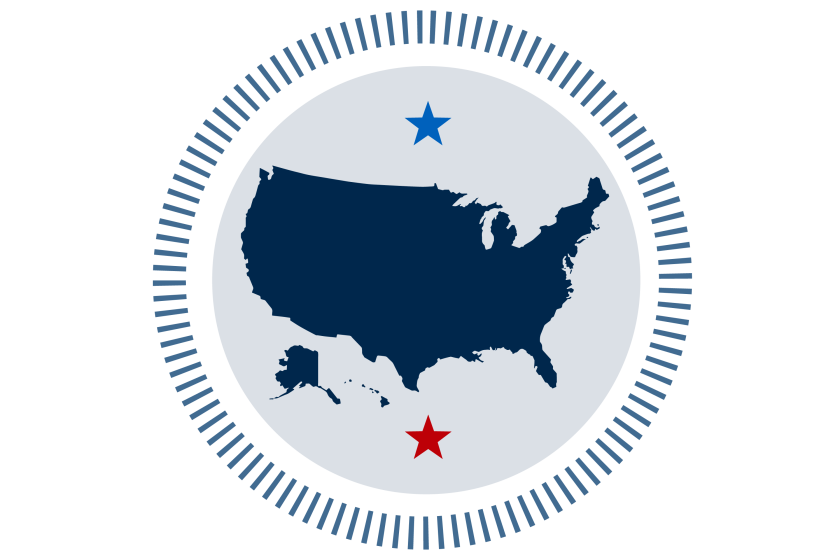Illegal immigrants again in the budget spotlight
As California lawmakers struggle with a budget gap that has now grown to $26.3 billion, one of the hottest topics for many taxpayers is the cost to the state of illegal immigrants.
The question of whether taxpayers should provide services to illegal residents became a major political issue in California’s last deep recession, culminating in the ballot fight over Proposition 187 in 1994. That history could repeat itself in the current downturn, as activists opposed to illegal immigration have launched a campaign for an initiative that would, among other things, cut off welfare payments to the U.S.-born children of illegal immigrants. Those children are eligible for welfare benefits because they are U.S. citizens.
State welfare officials estimate that cutting off payments to illegal immigrants for their U.S.-born children could save about $640 million annually if it survives legal challenges.
California has roughly 2.7 million illegal residents, according to an April 2009 report from the authoritative Pew Hispanic Center, accounting for about 7% of the state’s population. State officials estimate that they add between $4 billion and $6 billion in costs, primarily for prisons and jails, schools and emergency rooms. Beyond those services, the illegal population adds to the overall cost of other parts of local government, from police and fire protection to highway maintenance and libraries.
On the other side of the ledger, illegal residents pay taxes -- sales taxes on what they buy, gasoline taxes when they fuel their cars, property taxes if they own homes. The total is hotly debated, although most researchers agree that the short-term costs to state and local government are bigger than the revenues.
Many companies that hire illegal workers also withhold Social Security and income taxes from their paychecks, based on workers’ invalid Social Security numbers. That money goes mostly to the federal government, not to localities. The Social Security Administration estimates that in 2007, illegal residents nationwide contributed a net of $12 billion to the system.
The largest costs to California’s budget from its illegal residents are in three areas:
* Education: The state has no official count of how many students are in the country illegally because school districts do not ask. But the state legislative analyst estimated, based on data from the Pew Hispanic Center, that the state’s 6.3 million public school students include about 300,000 illegal residents. At an annual cost of about $7,626 each, the total comes to nearly $2.3 billion.
* Prisons: In fiscal year 2009-10, California expects to spend about $834 million to incarcerate 19,000 illegal immigrants in the state’s prisons. In Los Angeles County, illegal immigrants add between $370 million and $550 million annually to criminal justice costs, including prosecution, defense, probation and jails, according to Supervisor Mike Antonovich.
* Healthcare: The expected state tab for healthcare in fiscal 2009-10 is $703 million for as many as 780,000 illegal immigrants. Of that, $486 million goes to emergency services. But low-income illegal residents are also eligible for some nonemergency health services, including prenatal and postpartum care, abortions, breast and cervical cancer treatment and certain types of long-term care, such as stays in nursing homes. Most of the nonemergency care for illegal immigrants was authorized by the Legislature in the 1980s.
Much of those costs are beyond the control of state officials. The U.S. Supreme Court ruled in 1982 that the Constitution forbids school districts to turn away children who are illegal immigrants. And federal law requires emergency rooms to treat everyone, regardless of citizenship.
How serious a problem those costs are is a subject of constant debate. “It is a catastrophic hit . . . on every level of government,” Antonovich said.
State Sen. Denise Moreno Ducheny (D-San Diego) who heads the Senate budget committee, counters that illegal immigrants are net contributors through their taxes and labor in farming and other industries. Cutting services to illegal residents is “penny wise and pound foolish,” Ducheny said.
The Center for Continuing Study of the California Economy, based in Palo Alto, has analyzed research on the costs of illegal immigration. Most studies show that at least in the short term, illegal immigrants, who tend to be poorer and have more children than average, use more in public services than they contribute in taxes, the center found.
But the center’s director, Stephen Levy, said some of the long-term effects were positive. Educating illegal immigrant children, for instance, helps them eventually land better jobs and higher salaries, benefiting Californians with increased tax payments and more sophisticated work skills.
Gov. Arnold Schwarzenegger has said it is wrong to blame illegal immigrants for the state’s fiscal problems. He has, however, proposed to limit welfare and nonemergency healthcare for illegal immigrants and their families. So far, the Legislature has rejected his plans.
One of the governor’s proposals would place a five-year limit on state welfare payments to the U.S.-citizen children of illegal immigrants. That would affect approximately 100,000 U.S.-born children in about 48,000 California households headed by illegal immigrants, who receive a monthly average of $472. The measure could save $77 million annually, according to the governor’s office.
Under another proposal, the governor could commute the sentences of some illegal immigrant felons in state prisons and shift them to federal detention centers. It costs the state $48,000 to incarcerate a prisoner, and the federal government reimburses about 12 cents on the dollar, according to state finance officials. The administration estimates that commuting sentences of 8,500 felons, along with other sentencing changes, could save $182 million, although other state analysts question that.
State cuts in health services could shift costs to counties, some of which have begun denying treatment to illegal immigrants to close their own budget gaps. “It really is a punt,” said Farra Bracht of the Legislative Analyst’s Office. “We just keep shoving more and more to the counties. . . . They are the providers of truly last resort.”
Many state officials have called on the federal government to increase the payments it makes to the state for costs associated with illegal immigrants, because controlling the borders is a federal responsibility. So far, however, Washington lawmakers, faced with large deficits of their own, have not been willing.
And others say the nation’s humanitarian traditions and long-term interests compel extending a helping hand to people such as Delia Godinez.
Godinez, a 43-year-old undocumented Mexican immigrant, left an abusive family and lives in transitional housing. Four of her five children are citizens and receive a total of about $650 each month from the state’s CalWorks program. She also receives about $500 in federal food stamps and other vouchers.
Without the aid, the unemployed Godinez said, she wouldn’t be able to provide for her family. She is studying English and hopes one day to open a business and get off welfare.
“I don’t want to be my whole life with that help,” she said.
Many advocates say the ultimate solution is to reduce illegal immigration, not to cut off critical services that could jeopardize public health and safety.
“When people come into the U.S., even illegally, they cross more than a physical barrier; they cross a moral barrier,” said Steven Camarota of the Washington-based Center for Immigration Studies, which advocates immigration restrictions. “We don’t like it if someone can’t go to the emergency room. That’s just our way.”
--
More to Read
Get the L.A. Times Politics newsletter
Deeply reported insights into legislation, politics and policy from Sacramento, Washington and beyond. In your inbox three times per week.
You may occasionally receive promotional content from the Los Angeles Times.











